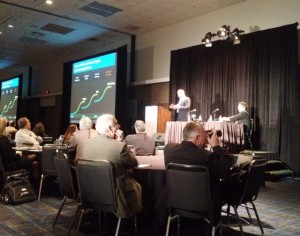March 4, 2013
“Is being a doctor enough or will the future doctor must also be a technologist?” Dave Evans, Chief Futurist, Cisco, kicked off Cisco’s Community for Connected Health Summit today at HIMSS 2013. With voice technology, augmented reality, gesture recognition and digital signage being implemented in the healthcare industry at a rapid rate, doctors are being pushed to their limit to understand and utilize these technologies to better communicate with providers, hospital staff and patients alike.
Evans stated that the exponential growth of the Internet is leading to more than 50 billion connected things that can communicate amongst one another, and it’s not a matter of ‘if’ the healthcare industry must adapt, but rather ‘when’ it’s possible to do so. There is an information explosion taking place and it’s not going to end anytime soon. By the end of 2013, we will create more information every 10 minutes than we did in all of human history, as of 2008. The zettaflood will place huge demands on the network. Demand optimized architectures for security, quality of service, and efficiency will be especially important for the healthcare industry.
Just last year we saw 44 million downloads of mobile health applications. It is expected that the number of downloads will exceed 140 million by 2016. Today, these applications are used to manage devices that we simply hold and wear. Tomorrow, these applications will be used to manage devices embedded within us, and the collection of all the data from these applications is where the complexity and challenges really come into play. It has been reported that by 2020, one-third of all data will live in or pass through the cloud. Cloud is fast becoming an enabler for communication, but how can it truly enhance telehealth?
Today, Cisco announced the results of the Cisco Customer Experience Reportfocused on health care. The global report examined the perceptions of consumers and health care decision makers on the patient experience in health care. While consumers still depend heavily on in person medical treatments, given a choice between virtual access to care and human contact, three quarters of patients and citizens would choose access to care and are comfortable with the use of technology for the clinician interaction. The report also found that most consumers are comfortable with having all of their health records securely available on the cloud.
With consumers feeling confident about information sharing through technology, vast opportunity lies ahead in cloud adoption for the healthcare industry and advancements in telehealth. All that is dependent upon health care decision makers though, as they must embrace technology and the rapid evolution taking place today if they are truly to be able to unlock technology’s full potential for the future.
Stay tuned for more from HIMSS, including additional results from the Cisco Connected Experience Report, and highlights from Cisco’s Community for Connected Health presentations from David Langer of North Shore-LIJ Health on transforming patient engagement, Thad Seymour of Lake Nona on their connected health community and Mark Blatt with Intel on a collaborative discharge process.



Do you know if that figure for downloads is US, or…?
The 44 million projected downloads was from a Juniper Research report. It was a global number.
The challenge is not in getting doctors to become technologists. We have been using advanced technology for centuries, and despite the mistaken belief that we are luddites, we take up new technology that is useful very readily.
The real challenge is to get technologists, in particular IT folk to become more attuned to what good quality healthcare is. It is not just measiring variables to infinite accuracy for prolonged periods. Whilst that fills s called “big data” repositories there is no evidence that it provides any real benefit to the patient. Healthcare is about doing something, not just measuring. The measurements need to serve a purpose, and we need to concentrate on benefits for the patient.
Using technology for enhanced communications makes sense, and is a good use of technology, The barriers are not the doctors but the outmoded reimbursement systems that prevent doctors for being paid for delivering their services in new ways.
After performing a 14 hour operation, my doctor showed me his IPHONE, and said he would still be looking after me via that device, as long as I maintained the stability of it overnight in the ICU. There was a risk of having to go back to surgery if the oxygen level to the tissue dropped and we would be back to “square one”. Imagine my comfort, knowing that he was “there” even though he wasn’t! I am so grateful to those that make these miracles happen every day!